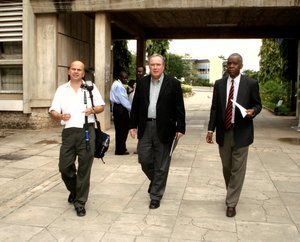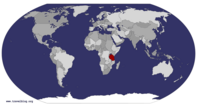Advertisement
Published: August 24th 2009

 Bill, Dan and Lennard
Bill, Dan and Lennard
Entering University of Dar es Salaam -
Our group was smaller—only Lennard, Dan, Bill, Hudson, Sheiba, Martin and I would do the day's activities. We were late for our appointment with Professor Rwekasa S. Mukandala, Vice Chancellor, University of Dar Es Salaam (USDM), but he was kind enough to rearrange his schedule and meet with us.
The history of USDM is quite interesting. Begun in 1961 as an affiliate college of the University of London, the Tanzanian Parliament established the institution as a full-fledged University nine years later. The sprawling campus is spread over more than 1600 acres, with a total student enrollment in 2007/2008 of almost 20,000. The goals include academic excellence and integrity, as well as a holistic approach to teaching and learning. Many people I met during the two trips to Tanzania were graduates of the University and/or were on the faculty.
Dan discovered that he and Professor Mukandala had something in common: Both of them have degrees from University of California at Berkeley.
During our brief meeting, the Vice Chancellor talked about the way he hoped we would portray the people of Tanzania. He emphasized their energy, competence and the ability to undertake stewardship of

 Sheiba and Martin
Sheiba and Martin
Organize the schedulethe country. He said fights over global natural resources will get worse, and potentially there will be food lines within 10-15 years. That's why the world must begin taking steps now to avoid problems later.
The campus is so large that we drove a while before reaching the School of Journalism and Mass Communication (SJMC). How fortunate that we were greeted by not one, but two Deans. It was the last day as the school's leader for Dr. Mwajabu Possi and the first day for Dr. B. Killian. And I might add, both were women.
We didn't understand Dr. Possi at first when she said she was a “Buckeye,” Then she repeated it and said she went to Ohio State University! She also went to Ball State in Indiana and Harvard Medical School—quite an impressive background. Dr. Killian earned her Ph. D. at UCLA (University of California, Los Angeles)—stellar credentials as well.
SJMC is a teaching and research institute. Courses are broad based, preparing students for a career in print, photography, TV broadcast and/or on-line media production. Public relations and advertising are covered as are other related areas.
We realized that this would be a way
to engage the local population in our project. We may be able to use some of the students as interns and give them practical experience. At the same time, we may also be able to learn from them.
The studio was not far away, so we walked there to meet the people and see the equipment. Many shoes were outside the door, though I didn't know the reason. Still, I removed mine, too. Bill showed his hi-def camera, and everyone was fully engaged.
I glanced at the monitors in the other room and saw words on the screen: “G20 PROTESTS” “MASSIVE SECURITY OPERATION...” The crawl said “PRESIDENT OBAMA HAS ARRIVED...” I hadn't watched the news since leaving Houston, so was completely unaware of world events.
We left for a short courtesy call on Dr. Isaac Marobhe, Head of Geology which means he oversees the work of our friends Hudson, Majura and Fredrick. He stressed the importance of focusing on young people, so that they will be interested in pursuing science. The professor also discussed natural disasters and the possibility of lessening their effects on the population. Animals react to earthquakes first. If we follow them, we may
be able to forecast where quakes will happen and broadcast warnings that might reduce the number of casualties. Additionally, we could follow wildebeests to find new sources of water.
Since it was late, and we hadn't had lunch, we thanked the professor and left. Lennard was once a lecturer in Civil/Structural Engineering at USDM, so knew a place for us to eat. He had the drivers take us to the faculty club which was unlike any I've ever seen. It was outdoors, with tables and chairs under exotic trees.
The food was unusual as well. He asked if I liked fish. Since many of my meals in Tanzania had been chicken, I wanted to try something different. It was different all right. The plate had beans, rice, cabbage and fish heads covered by a sauce. I was glad the eyes were removed. It would have been strange looking at the fish and having it look back at me. Actually, the changu, a sea fish resembling tilapia, was tasty, though there were almost more bones than meat.
We relaxed while Lennard told stories of his youth. The weather was pleasant, and we were completely at peace. It was
a good way to unwind after the hectic activities of the past few days and the new ones that would begin in the morning.
While Dan, Hudson, Sheiba and Martin went back to the hotel, Lennard had a surprise for Bill and me. He introduced us to his cousin Ms. Mwanyika and asked for a good place to shop. She suggested we go to Africa Sana down the street.
I intended to get a nice African shirt for my husband Howard, and that was all. The young sales woman was full of smiles. I found what I wanted and was ready to leave, but that didn't happen. First Bill and Lennard had me try on two authentic African hats. They wanted me to buy one, but it wouldn't have fit in my suitcase. “Wear it on the plane,” they said. Like I'd really travel for 27 hours with it on my head! Right!
While we were discussing it, the young gal came out in a lovely African dress that had one shoulder strap. The other shoulder was covered by extra cloth that wrapped around her. She said. “You should have one of these.” At first I said
I was too old, but the guys convinced me to look for a dress with colors I wanted and try it on.
To placate them, I found one, and she went into the dressing room with me to help me put it on properly. They were all smiles when I came out and said it was perfect, but the sales gal said, “You're not finished yet.” She brought me yellow beaded earrings, matching necklace, bracelet, ankle bracelet and something that wraps around like a head band and said, “Now you're done.”
I had to admit, it looked better than I thought it would. They insisted, “You have to buy it!” I did. As she was writing the sales slip, I learned her remarkable story. She was a Tutsi from Rwanda. Her parents were killed during the ethnic cleansing, and she brought her siblings to Tanzania. She was probably no more than 20 years of age and was the oldest, so was working to put them through school. She said that after the last one graduates, she'll go to school herself.
She was bright and will succeed in whatever she decides to do. But the remarkable thing was
her spirit—accepting her fate without bitterness. And her big heart. She gave to her siblings unselfishly with no resentment for the sacrifices she was making.
Lennard later told me that both Tutsis and Hutus reside in Tanzania and nearby countries where they live harmoniously. They identify with their adopted homes, not with their ethnicity. Let's hope that time heals the wounds, and that the horrendous period in history is over.
We returned to our hotel, and I packed for the next part of the trip. Since we needed to travel fairly light, I put what I would need in my rolling duffel. Everything else went into the regular suitcase that would be checked at the hotel.
We four went our separate ways. Lennard had many relatives in town and was their father figure. He went to see them.
The hotel was having a “meet and greet” reception, so I thought I'd stop there for a while. It was fairly dark outside where it was held, so I couldn't see people that well. A woman came up to me, and we started talking. Karen Johnson Lassner was American-born and works for a company that strengthens health programs
throughout the world. They have offices in Massachusetts and Brazil. She's one of several people I met in Tanzania who are involved in projects for improving governance, education, banking and other sectors that will impact the lives of Africans in a positive way.
We talked to several guests who were executives in a mobile phone company. Though we were from diverse countries, we were able to find common interests. The hors d'oeuvres were filling, so there was no need to go to dinner. I went back to take a nice leisurely bath and fell asleep quickly.
Please click on PREVIOUS Entry to continue. Click on photos to enlarge.
Advertisement
Tot: 0.072s; Tpl: 0.012s; cc: 7; qc: 24; dbt: 0.0333s; 1; m:domysql w:travelblog (10.17.0.13); sld: 1;
; mem: 1.1mb

















